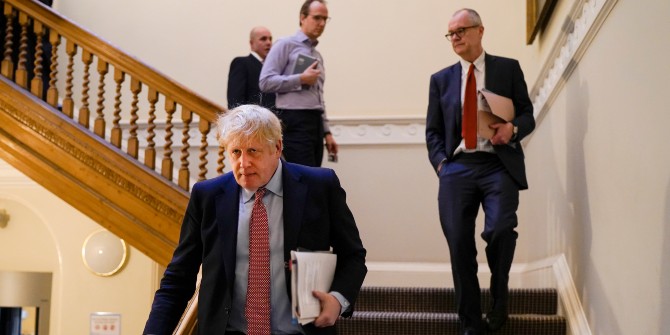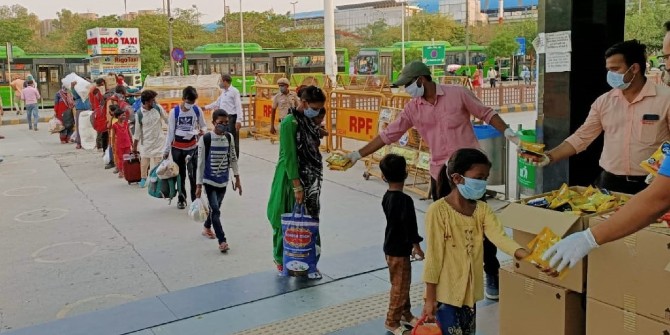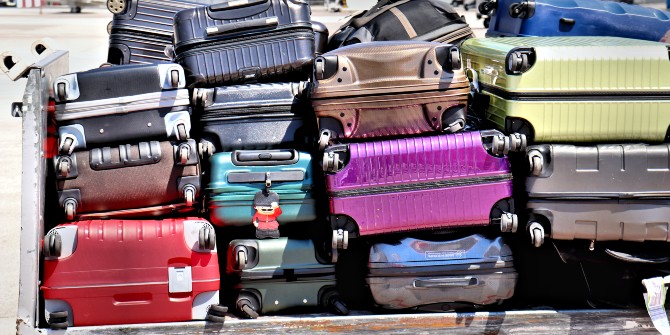The world is often said to have prepared for the wrong kind of pandemic, anticipating a new strain of influenza. In fact, says Celia Blanco-Jimenez (LSE), a number of plans were in place for the rapid spread of a respiratory disease. But none anticipated that lockdowns or travel restrictions would be put in place.
Accounts of the chaos and confusion in No 10 in March 2020 would imply that COVID-19 caught the UK completely unprepared. Nonetheless, the government carried out extensive planning for a pandemic, mostly focusing on influenza. We knew that an airborne pathogen of unknown lethality was highly likely to emerge. In the event, the world ultimately departed from its pandemic planning and took unprecedented steps to contain the virus.
Numerous reports warned of the high likelihood that a new virus of unknown severity would spread from animals to humans and create a pandemic. A report from the Home Office stated the ‘high probability’ of this occurring as long ago as 2008. The World Health Organisation reported “a world at risk” in 2019, and the Johns Hopkins Center for Health Security Preparedness for a High-Impact Respiratory Pathogen Pandemic warns about “a very real threat of a rapidly moving, highly lethal pandemic of a respiratory pathogen”. In 2011, the Department of Health said a pandemic could arise in any location, although many previous pandemics had originated in China or Southeast Asia.
So why were we not better prepared for COVID-19? A popular hypothesis is that we prepared for the wrong pandemic, and an outbreak of influenza was most likely. According to the WHO, both coronavirus and influenza are “transmitted by droplets and fomites, and the same public health measures are important actions all can take to prevent infection”. The UK preparedness plan for influenza is also alert to the possibility of a novel virus with an unknown incubation time, which in a “reasonable worst-case scenario” would have a fatality rate of 2.5% (higher than COVID-19), spreading over one or more waves, causing high levels of work absence and disruption to the economy. It also anticipates that vaccines will take at least four to six months to develop.
Moreover, the SPI-M report warns that “pandemics are heterogeneous, the next pandemic will be unique in many ways (…) and we should ensure that all intervention strategies are able to accommodate the full range of possible disease parameters…”, and warned against using the experience of the H1N1 virus in 2009 to predict the severity of the next pandemic. The Global Preparedness Monitoring Board (GPMB) and the World Bank (2006) anticipated a “worst case scenario” of a novel virus similar to the Spanish flu, killing 50-80 million people.
So the world was aware that there was a high likelihood of a new virus emerging, that it would probably be a respiratory virus, would spread quickly and was likely to emerge from Southeast Asia. It had reports modelling the potential social and economic loses for a pandemic much more virulent than COVID-19 that would require similar non-medical interventions. Why, then, were we only prepared for influenza?
What were the plans?
Most of the measures recommended in national and international pandemic plans can be summarised as detection, assessment, and Personal Protective Equipment (PPE) supply for healthcare workers. For the general public, the focus is on handwashing, voluntary isolation when ill, and waiting for the development of a vaccine. All these measures should serve as a benchmark that could be adjusted for different pathogens.
The National UK Risk register in 2017 and the UK influenza pandemic preparedness strategy 2011 (most of which was not updated in subsequent years, although a 2017 update provided for school closures and the cancellation of mass events), highlighted several action plans, mostly relying on detection, hygiene, pharmaceutical interventions (vaccines), and protective equipment. In terms of non-medical interventions, this report argues there is not enough evidence to justify mask-wearing by the general public, rejects closing borders in the event of a pandemic, suggests models that impose a 90% restriction on all air travel will only delay a pandemic wave by 1-2 weeks, and argues that the economic, political and social consequences of border closures would be very substantial.

Internationally, the WHO report on non-pharmaceutical interventions (2019) gives similar advice. The main recommendations are hand hygiene, mask-wearing by symptomatic individuals, surface cleaning, ventilation, voluntary isolation of sick individuals (highlighting the ethical considerations), and travel advice. Home quarantine, screening for travellers, and contact tracing are not recommended, while school and workplace closures should be based on severity. Internal travel restrictions are only recommended during the early stage of a localised and extraordinarily severe pandemic, and for a limited period of time. Border closure is not recommended as “it can lead to discrimination and stigmatisation of individuals from affected areas”.
But were we prepared?
The United Nations and WHO define preparedness as “the ability (knowledge, capacities, and organisational systems) of governments, professional response organisations, communities and individuals to anticipate, detect and respond effectively to, and recover from, the impact of likely, imminent or current health emergencies”.
The 2019 Global Health Security Index declared the UK one of the best-prepared countries in the world for a pandemic, even ahead of countries like Japan or South Korea. However, the Exercise Cygnus Report (2016), commissioned by the NHS, predicted shortages of ICU beds and PPE, and stated that regulatory changes were needed to improve the ability of the health and other sectors to cope with an outbreak, as well as changes and easements to assist with the implementation of a response. The report also identified a lack of joint tactical plans and a lack of capacity among local responders. Interestingly, the report was classified until October 2020, when it was published following public pressure.
At an international level, the GPMB warns that respiratory pathogens pose “global catastrophic biological risks”, and that the world was not prepared for a fast-moving, virulent respiratory pathogen pandemic. It also claimed that “preparedness is hampered by the lack of continued political will at all levels”, and that the great majority of national health systems would be unable to handle a large influx of patients infected with a respiratory pathogen capable of easy transmission and high mortality. Similarly, the Johns Hopkins Center for Health Security (2019) claims that “International Health Regulations (IHR) core capacities are unlikely in their current formulation to adequately prepare countries and the international community for high-impact respiratory events”. So were we really well prepared for a potentially severe influenza epidemic, as is claimed?
Furthermore, none of the reports highlighting the gaps in systems or plans identified a lack of stronger social distancing measures or travel restrictions as potential problems. They did not even consider national lockdowns or compulsory quarantine.
What actually happened?
In the event, the Wuhan Municipal Health Commission made its first statement about a ‘viral pneumonia’, later confirmed to be a coronavirus, on 31 December 2019. This was confirmed by the WHO as an outbreak on 30 January. During January numerous countries confirmed their first cases, closed their borders, and evacuated their nationals from Wuhan, while China imposed quarantines on five cities. In the WHO’s Strategic Preparedness and Response Plan on 3 February 2020, the WHO seems to detract from previous recommendations, and timidly recommends restrictions on movement due to the high uncertainty.
On 10 February, the UK declared COVID-19 a serious threat. Nine days later, Italy closed public spaces before the first death, when there had only been 2,129 recorded deaths globally. On 9 March it announced a nationwide lockdown. Travel bans to and from China were brought in. On 11 March, COVID-19 is declared a pandemic by the WHO. By mid-March, many countries have banned mass gatherings, cancelled events, closed borders, and suspended flights to infected areas. On 17 March, the EU closed its borders. Six days later the UK imposed lockdown, and by 25 March a third of the world’s population was in lockdown. Although medical supplies were essential to most international pandemic plans, during March 2020 the world suffered severe shortages of PPE.
Only a month and a half after COVID-19 was declared a pandemic, most countries had ignored their previous plans, both national and international, and imposed measures that had not been recommended even in the event of a much more virulent pandemic. In the UK, in particular—despite numerous warnings—the preparations that were made underestimated the impact the virus would have on the NHS, the public’s aversion to the prospect of health services being overwhelmed, and perhaps the relative ease with which some in-person activity could move online.
This post represents the views of the author and not those of the COVID-19 blog, nor LSE.





